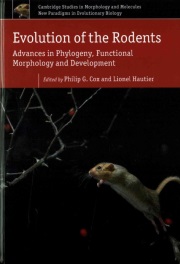Evolution of the Rodents
 Philip G Cox and Lionel Hautier (Eds)
Philip G Cox and Lionel Hautier (Eds)
Cambridge University Press
£74.99
Rodents are prolific, comprising over 40% of mammals, 2,277 species (and counting), including climbers, gliders, swimmers and burrowers, and representing the most numerous wild terrestrial vertebrates. Few volumes can do them justice. As a long-overdue successor to a 1985 edition by Luckett and Hartenberger supported by NATO, the 20 papers here examine the latest thinking, techniques and discoveries.
Given the title, the coverage concerns facets of rodent evolution in a phylogenetic, biogeographic and fossil context as opposed to living species. Nucleotide-based phylogenies have played an important part in unravelling rodent history, given they are not well fossilised. The initial chapters settle a debate on whether rodents are related to lagomorphs, followed by a comprehensive overview of rodent diversity – there is a minor error (on page 42) mentioning an African radiation of Funambulini when they are associated with Asia.
Fossil groups are well covered, including an assessment of the largest rodent from South America, Josephoartigasia monesi, a 1,000kg Pleistocene herbivore related to the pacarana. There are sweeping accounts of the evolution of squirrels, marmots and other rodent radiations across the continents, as well as technical accounts of cranial characteristics, such as the musculature of the jaw, the inner ear and, in particular, dentition.
The combination of palaeontology, biogeography, taxonomy and anatomy makes for a deep, analytical and selective approach allowing for gaps in knowledge. For their diversity, rodents receive less attention than carnivores or primates, and this collection is a culmination of research that will certainly inform and rouse budding rodentologists, to echo the foreword. A major reference work.
Rajith Dissanayake AMRSB


